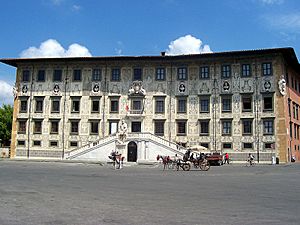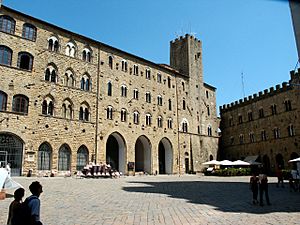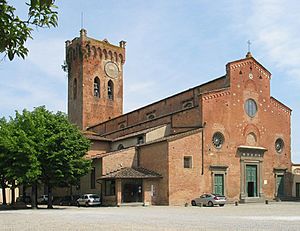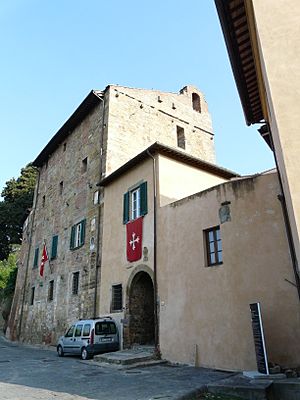Province of Pisa facts for kids
Quick facts for kids
Province of Pisa
Pisa
|
|
|---|---|
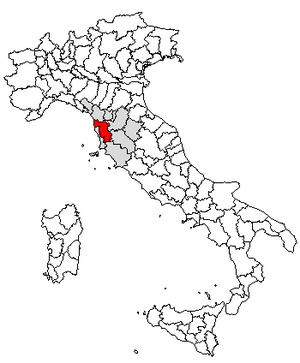 |
|
| Country | |
| Region | Toscana |
| Capital | Pisa |
| Area | |
| • Total | 2,448 km2 (945 sq mi) |
| Population | |
| • Total | 394,101 |
| • Density | 161/km2 (420/sq mi) |
| Postal Code |
56010, 56011, 56017, 56019-56022, 56025, 56027, 56029-56038, 56040-56043, 56046, 56048
|
| Telephone prefix |
050, 0565, 0571, 0586, 0587, 0588
|
| ISTAT | 050 |
| Vehicle registration | PI |
| No. of communes | = 39 |
The Province of Pisa (called Provincia di Pisa in Italian) is a region in central Italy, located in Tuscany. Its main city is Pisa. It's a pretty big area, about 2,448 square kilometers (945 square miles), and in 2014, about 421,642 people lived there. It's divided into 37 smaller towns and areas called comuni.
The history of the Province of Pisa goes back to ancient times, with groups like the Etruscans and Phoenicians. In the 1100s and 1200s, this area became very powerful in the Mediterranean Sea. The city of Pisa, which is the capital, is famous for its Leaning Tower and other old buildings that many tourists visit.
Contents
History of Pisa Province
The area around Pisa has a long history connected to the sea. Ancient groups like the Etruscans, Phoenicians, and Gauls lived here. When it was part of the Roman Empire, Pisa's navy helped fight against other groups like the Ligurians and Carthaginians. Pisa became a Roman colony in 180 BC. Later, Julius Caesar gave it even more independence.
After the Roman Empire fell, Pisa managed to stay strong. Its river system helped it fight against Saracen pirates. In 828, Pisa sent ships to attack the coast of North Africa. In 871, Pisan soldiers even helped defend the city of Salerno from the Moors.
Pisa as a Republic
In the 11th century, Pisa became its own republic. This means it was an independent state ruled by its citizens. It was most powerful in the 12th and 13th centuries. At this time, Pisa's navy controlled the western Mediterranean Sea. Its influence spread far beyond Italy.
Pisa was first an ally, then a rival, of the Republic of Genoa. But in 1284, Pisa lost a big naval battle called the Battle of Meloria. After this defeat, Pisa's power began to fade. In 1406, it was taken over by Florence. Later, in the 16th century, it became part of the Grand Duchy of Tuscany.
Modern History of the Province
In the 20th century, Pisa suffered a lot during World War II. It was heavily bombed by Allied forces, and there were also harsh actions by the Nazis.
The current Province of Pisa comes from the old Grand Duchy of Tuscany. Its lands were once part of the powerful Maritime Republic of Pisa. Over time, some towns moved to different provinces. For example, in 1925, several towns like Cecina and Piombino became part of the Province of Livorno. At the same time, towns like San Miniato and Santa Croce sull'Arno joined the Province of Pisa from Florence.
Geography of Pisa Province

The Province of Pisa is located in western Tuscany. It stretches from the flat lands of the Arno River to the Ligurian Sea. The province looks a bit like a gun turned upside down on a map!
To the north, it shares a border with the Province of Lucca. To the east, it borders the Metropolitan City of Florence and the Province of Siena. The Province of Grosseto is to the south, and the Province of Livorno and the Ligurian Sea are to the west.
Mountains and Coastline
The northern part of the province has mountains. These are part of the Apennine mountain range, called Mount Pisano. This range separates Pisa from Lucca. The highest point in Monte Pisano, and in the whole province, is Monte Serra, which is 917 meters (3,009 feet) high.
The coast of Pisa is about 15 kilometers (9 miles) long. It includes popular places like Calambrone, Tirrenia, and Marina di Pisa. A part of the coast near San Giuliano Terme and Vecchiano is protected as a park.
Hills and Valleys
While the area right around Pisa city is flat, a few miles south, the landscape changes. You'll find classic Tuscan hills, forests, and old villages. A notable area in the south is the Val di Cecina, which is the valley of the Cecina River. The ancient city of Volterra is also in this southern part. The southern hills include the peak of Monte Aia dei Diavoli, which is 867 meters (2,844 feet) high.
Population of Pisa Province
Records show that the population of the Province of Pisa has grown steadily over time. In the 1860s, about 240,000 people lived here. By the 1990s, this number grew to around 390,000. Since the year 2000, the population has increased by about 30,000 people, reaching over 420,000 today.
As of January 1, 2014, the ten largest towns in the province by population were:
- Pisa (88,627 people)
- Cascina (44,901 people)
- San Giuliano Terme (31,315 people)
- Pontedera (28,915 people)
- San Miniato (28,072 people)
- Ponsacco (15,609 people)
- Santa Croce sull'Arno (14,528 people)
- Castelfranco di Sotto (13,431 people)
- Santa Maria a Monte (13,197 people)
- Casciana Terme Lari (12,536 people)
Towns and Villages
The Province of Pisa is divided into 37 smaller areas called comuni (municipalities). Here is a full list of these comuni:
- Bientina
- Buti
- Calci
- Calcinaia
- Capannoli
- Casale Marittimo
- Casciana Terme Lari
- Cascina
- Castelfranco di Sotto
- Castellina Marittima
- Castelnuovo di Val di Cecina
- Chianni
- Crespina Lorenzana
- Fauglia
- Guardistallo
- Lajatico
- Montecatini Val di Cecina
- Montescudaio
- Monteverdi Marittimo
- Montopoli in Val d'Arno
- Orciano Pisano
- Palaia
- Peccioli
- Pisa
- Pomarance
- Ponsacco
- Pontedera
- Riparbella
- San Giuliano Terme
- San Miniato
- Santa Croce sull'Arno
- Santa Luce
- Santa Maria a Monte
- Terricciola
- Vecchiano
- Vicopisano
- Volterra
Economy and Industry
The Province of Pisa has many different types of businesses. One very important industry is leather and footwear. About 800 companies here make shoes and leather goods. They employ around 10,000 people and produce 35% of Italy's total in this area! Clothing production has also been growing since 2003.
There are also companies in the chemical and pharmaceutical industries. Research facilities have been developed in towns like Cascina and Pontedera. Many software development and IT companies are also found here.
Even though the economy has faced challenges recently, agriculture continues to grow. This is thanks to traditional crops, wine making, and growing different fruits and vegetables. Other growing areas include technology and glass production.
Tourism is also a big part of the local economy. Many people visit the province to see its famous sights.
Main Sights and Attractions
Besides the many famous places in the city of Pisa itself, like the Leaning Tower, the cathedral, and the Carovana Palace, the province has many other interesting towns and villages to explore.
Historic Cities
- The historic city of Volterra is known for its beautiful cathedral. You can also see ancient Etruscan and Roman ruins there. The city has many museums, churches, and old palaces.
- The medieval city of San Miniato sits on top of three hills. It has a cathedral, a fortress tower, two palaces, and many old churches.
Charming Villages
The province is home to many charming villages:
- Vicopisano is a village with an old fortress and towers.
- Calci is home to the Charterhouse, which is now a museum.
- Buti has a castle and a historic Medici villa.
Other Interesting Places
- The Villa di Corliano is a beautiful villa in San Giuliano Terme.
- Castelfranco di Sotto is a medieval village that was once gated.
- Montopoli in Val d'Arno has interesting old towers.
- Peccioli is known for its bell-tower.
- The Rocca Sillana fortress is a strong old building in Pomarance.
See also
 In Spanish: Provincia de Pisa para niños
In Spanish: Provincia de Pisa para niños


